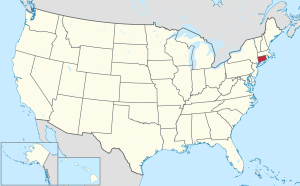Lower Connecticut River Valley Planning Region, Connecticut
 From Wikipedia - Reading time: 8 min
From Wikipedia - Reading time: 8 min
Lower Connecticut River Valley Planning Region | |
|---|---|
| Lower Connecticut River Valley Council of Governments (RiverCOG) | |
From top left: Gillette Castle State Park, Connecticut River Museum, Essex Village, North Cove in Old Saybrook, Main Street Historic District in Middletown | |
 Location within the U.S. state of Connecticut | |
 Connecticut's location within the U.S. | |
| Coordinates: 41°28′N 72°31′W / 41.47°N 72.51°W | |
| Country | |
| State | |
| Founded | 2013 |
| Largest city | Middletown |
| Government | |
| • Executive Director | Samuel S. Gold |
| Area | |
• Total | 424.1 sq mi (1,098 km2) |
| Population (2020) | |
• Total | 174,225 |
| Time zone | UTC−5 (Eastern) |
| • Summer (DST) | UTC−4 (EDT) |
| Congressional districts | 1st, 2nd, 3rd |
| Website | rivercog |
The Lower Connecticut River Valley Planning Region is a planning region and county-equivalent in Connecticut. It is served by the coterminous Lower Connecticut River Valley Council of Governments (RiverCOG). In 2022, planning regions were approved to replace Connecticut's counties as county-equivalents for statistical purposes, with full implementation occurring by 2024.[1][2]
Demographics
[edit]| Census | Pop. | Note | %± |
|---|---|---|---|
| 2020 | 174,225 | — | |
| 2022 (est.) | 176,622 | [3] | 1.4% |
| U.S. Decennial Census[2] | |||
As of the 2020 United States census, there were 174,225 people living in the Lower Connecticut River Valley Planning Region.[2]
Municipalities
[edit]The following municipalities are members of the Lower Connecticut River Valley Region:[4]
City
[edit]Towns
[edit]- Chester
- Clinton
- Cromwell
- Deep River
- Durham
- East Haddam
- East Hampton
- Essex
- Haddam
- Killingworth
- Lyme
- Middlefield
- Old Lyme
- Old Saybrook
- Portland
- Westbrook
References
[edit]- ^ "Governor Lamont Announces U.S. Census Bureau Approves Proposal for Connecticut's Planning Regions To Become County Equivalents". CT.gov. Retrieved March 24, 2023.
- ^ a b c "Change to County-Equivalents in the State of Connecticut". Federal Register. June 6, 2022. Retrieved March 24, 2023.
- ^ "U.S. Census Bureau QuickFacts: Lower Connecticut River Valley Planning Region, Connecticut; United States". www.census.gov. Retrieved May 13, 2023.
- ^ "Lower Connecticut River Valley Council of Governments". Retrieved March 24, 2023.
External links
[edit]Wikimedia Commons has media related to Lower Connecticut River Valley Planning Region, Connecticut.
Licensed under CC BY-SA 3.0 | Source: https://en.wikipedia.org/wiki/Lower_Connecticut_River_Valley_Planning_Region,_Connecticut1 | Status: cached on December 02 2024 22:57:13↧ Download as ZWI file
 KSF
KSF






